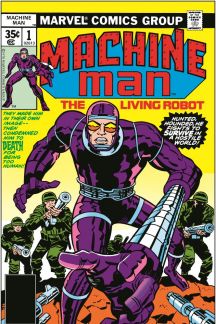|
In celebration of Jack “King” Kirby’s 100th birthday, we’re been reviewing the man’s legendary creations with a year-by-year examination of his unparalleled career at Marvel Comics. Read on for our final installment of the History of Kirby and witness more of the work that made him comic book royalty.
Though wrapping up what would be his last year of work for Marvel in 1978, Jack Kirby’s creativity reached an amazing new plateau as he debuted two new series as well as two singularly fantastic standalone projects.
Jack kicked off the year with his last cover for perhaps his greatest co-creation of all time. FANTASTIC FOUR #190 showed off the team surrounded by symbolic shots of their major arch-enemies, a fitting illustration for the artist to end on. Later, seemingly not done with the idea of the Fantastic Four, Jack wrote and drew WHAT IF? #11, a fun take on the first family of super heroes that replaced Mr. Fantastic, the Invisible Girl, the Human Torch, and the Thing with the real-life Marvel Bullpen staff of Stan Lee, Flo Steinberg, Sol Brodsky, and Jack himself.
Stan and Jack also collaborated on an immense project, their last as a duo. The SILVER SURFER graphic novel of 1978, written by “The Man” and illustrated by “the King,” took readers on a far-flung “Ultimate Cosmic Experience” with the Surfer to pit him once again versus the world-eating Galactus. One of the very first graphic novels ever, the tome ended up in bookstores, bringing Marvel into a whole new arena.
Jack brought his two series from the previous year, ETERNALS and BLACK PANTHER to an end in 1978, or at least to a stopping point for himself. In ETERNALS #19, he drew the climax of a gigantic, sprawling battle between the various races in the saga, and over in BLACK PANTHER he fit in T’Challa’s origin story, a new team called the Musketeers, a first-time villain called Kiber the Cruel, and new psychic powers for the titular hero.
Never content with resting on his laurels, Jack also launched DEVIL DINOSAUR and spun MACHINE MAN out of his 2001 series. DEVIL DINOSAUR related the ongoing plight of Moonboy, an early relative to man, and a crimson dinosaur called Devil as they made their way through a prehistoric landscape to clash with fiends and foes along the way. In MACHINE MAN, Jack told the tale of X-51, a self-sentient robot that searched for his identity and his place in the world while fighting various factions that would end his quest.
As the year came to a close, Jack Kirby looked beyond comics to new horizons and, for a time, left the industry to pursue work in the ever-growing animation business. Eventually, he returned to his first love, comic books, and continued to build upon the legacy he crafted at Marvel with projects at new companies just starting out on their journeys.
|







